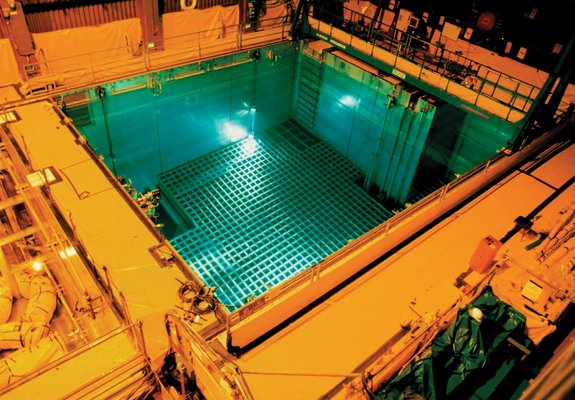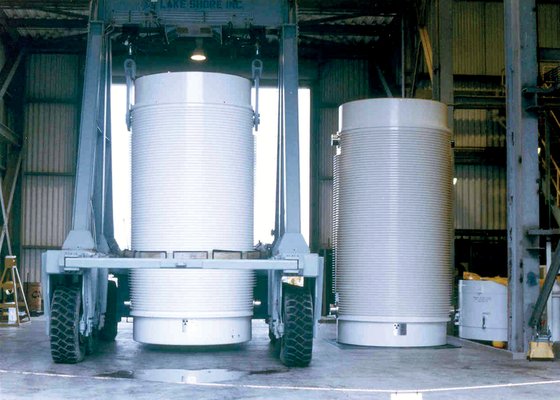
by Erin Wayman Thursday, January 5, 2012

Before being stored in dry casks, spent nuclear fuel spends time cooling off in a storage pool. Nuclear Regulatory Commission

Like current commercial nuclear power plant practices, an interim storage facility would store spent nuclear fuel in dry casks made of concrete, lead and steel. Nuclear Regulatory Commission
The United States is in a nuclear waste holding pattern. Yucca Mountain, the site of the proposed geological repository that is supposed to permanently store the country’s nuclear waste, was supposed to open in 1998. Controversy has led to numerous delays, and the repository won’t open until 2020 — assuming everything goes smoothly from here on out.
Meanwhile, Congress wants the U.S. Department of Energy to collect spent nuclear fuel from decommissioned reactors and store the waste at an interim storage facility. But DOE says it has no legal authority to do that. So unless Congress enacts new legislation, nuclear waste will continue to pile up at the dozens of nuclear power plants scattered around the country, despite the benefits of interim storage touted by some policymakers and stakeholders.
In the past 40 years, U.S. nuclear power plants have produced an estimated 58,000 metric tons of spent nuclear fuel, according to the Nuclear Energy Institute, with much of that waste stored onsite at power plants in storage pools and dry casks. That amount increases steadily as the plants continue operating. But the power plants are running out of space, says Steven Kraft, senior director for Used Fuel Management at the Nuclear Energy Institute, an industry group in Washington, D.C. About 2,800 metric tons of spent nuclear fuel sit on nine sites with decommissioned reactors where no other nuclear activities take place. Removing waste from these sites, Kraft says, would allow the land to be redeveloped for other purposes.
Last year, the House Appropriations Committee asked DOE to develop a plan to collect and temporarily store spent nuclear fuel from decommissioned reactors to “both reduce costs that are ultimately borne by the taxpayer and demonstrate that DOE can move forward in the near term with at least some element of nuclear waste policy.” The House suggested creating an interim storage facility that could be housed at an existing federal site, at one or more non-federal sites licensed by the Nuclear Regulatory Commission, or at a competitively selected site.
In December, DOE responded with a report that outlined the reasons why it cannot develop such a plan.
DOE says that legal technicalities that tie its ability to collect nuclear waste to progress on Yucca Mountain prevent the department from developing an interim storage facility. But the department did have the right to temporarily store spent nuclear fuel under certain conditions — until that right expired in 1990. Congress will need to enact new legislation, DOE says, before the department can develop an interim storage site.
Money is another concern. DOE estimates an interim storage facility would cost $743 million to build and operate, assuming the facility opens in 2015 at the earliest and transfers the last of its waste to Yucca Mountain by 2028. But lawsuits could drive up that price. DOE is supposed to collect nuclear waste using a principle of “oldest fuel first.” Preferentially taking waste from all decommissioned sites would violate this standard, DOE says, and would leave the department vulnerable to litigation. The department already faces an estimated $11 billion in litigation due to its failure to meet its contractual obligation to begin accepting spent nuclear fuel from commercial power plants in 1998. Adding more money to that figure would “not reduce taxpayer costs for waste disposal,” Ward Sproat, director of DOE’s Office of Civilian Radioactive Waste Management, said in a statement.
But Kraft says that the DOE report was too narrowly focused. DOE, he says, “did not explore or do any analysis of the strategic or political value of these sorts of facilities.” Additionally, he says, building an interim storage facility would probably be a lot easier than DOE officials suggest. For one, because it is only temporary, such a site does not need to meet the stringent geological requirements of a permanent repository. It can also use the same dry cask storage systems used by nuclear power plants today. And, Kraft says, if communities were allowed to give input and be part of the siting process, there might not be as much “not in my backyard” backlash.
Regardless of DOE’s report, the country’s long-term management of nuclear waste should include interim storage, Kraft says. “Interim storage is part of a three-pronged, integrated strategy for managing [nuclear] waste: store it, recycle it and dispose of what can’t be recycled.” Interim storage is important, he says, because “it’s going to take a long time to develop the other two.”
© 2008-2021. All rights reserved. Any copying, redistribution or retransmission of any of the contents of this service without the expressed written permission of the American Geosciences Institute is expressly prohibited. Click here for all copyright requests.